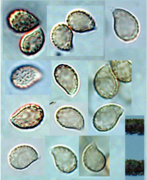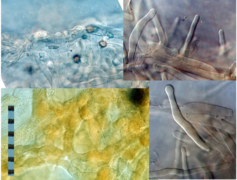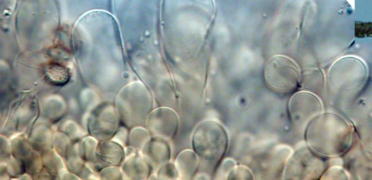
Basidiomycota is one of two large divisions that, together with the Ascomycota, constitute the subkingdom Dikarya within the kingdom Fungi. Members are known as basidiomycetes. More specifically, Basidiomycota includes these groups: agarics, puffballs, stinkhorns, bracket fungi, other polypores, jelly fungi, boletes, chanterelles, earth stars, smuts, bunts, rusts, mirror yeasts, and Cryptococcus, the human pathogenic yeast.

A basidium is a microscopic spore-producing structure found on the hymenophore of reproductive bodies of basidiomycete fungi. The presence of basidia is one of the main characteristic features of the group. These bodies also called tertiary mycelia, which are highly coiled versions of secondary mycelia. A basidium usually bears four sexual spores called basidiospores. Occasionally the number may be two or even eight. Each reproductive spore is produced at the tip of a narrow prong or horn called a sterigma (pl. sterigmata), and is forcefully expelled at full growth.

A basidiospore is a reproductive spore produced by basidiomycete fungi, a grouping that includes mushrooms, shelf fungi, rusts, and smuts. Basidiospores typically each contain one haploid nucleus that is the product of meiosis, and they are produced by specialized fungal cells called basidia. Typically, four basidiospores develop on appendages from each basidium, of which two are of one strain and the other two of its opposite strain. In gills under a cap of one common species, there exist millions of basidia. Some gilled mushrooms in the order Agaricales have the ability to release billions of spores. The puffball fungus Calvatia gigantea has been calculated to produce about five trillion basidiospores. Most basidiospores are forcibly discharged, and are thus considered ballistospores. These spores serve as the main air dispersal units for the fungi. The spores are released during periods of high humidity and generally have a night-time or pre-dawn peak concentration in the atmosphere.

Pluteus cervinus, commonly known as the deer shield, deer mushroom, or fawn mushroom, is a species of fungus in the order Agaricales. Fruit bodies are agaricoid (mushroom-shaped). Pluteus cervinus is saprotrophic and fruit bodies are found on rotten logs, roots, tree stumps, sawdust, and other wood waste. The species is common in Europe and eastern North America, but rare and possibly introduced in western North America.

Psilocybe subaeruginosa is a species of agaric fungus in the family Hymenogastraceae described in 1927 and known from Australia and New Zealand. As a blueing member of the genus Psilocybe it contains the psychoactive compounds psilocin and psilocybin.

Crepidotus versutus, commonly known as the evasive agaric, is a species of fungus in the family Crepidotaceae. It is saprobic on wood, like other Crepidotus species, but it can also decompose herbaceous forest litter. The species is characterized by large, punctate, ellipsoid spores, and the white, hairy pileus.

Coprinellus micaceus, commonly known as the mica cap, glistening inky cap, or shiny cap, is a common species of mushroom-forming fungus in the family Psathyrellaceae with a cosmopolitan distribution. The fruit bodies of the saprobe typically grow in clusters on or near rotting hardwood tree stumps or underground tree roots. Depending on their stage of development, the tawny-brown mushroom caps may range in shape from oval to bell-shaped to convex, and reach diameters up to 3 cm. The caps, marked with fine radial or linear grooves that extend nearly to the center, rest atop whitish stipes up to 10 cm (4 in) long. In young specimens, the entire cap surface is coated with a fine layer of reflective mica-like cells. Although small and with thin flesh, the mushrooms are usually bountiful, as they typically grow in dense clusters. A few hours after collection, the gills will begin to slowly dissolve into a black, inky, spore-laden liquid—an enzymatic process called autodigestion or deliquescence. The fruit bodies are edible before the gills blacken and dissolve, and cooking will stop the autodigestion process.

Amanita australis is a species of fungus in the family Amanitaceae. It produces small- to medium-sized fruit bodies, with brown caps up to 9 centimetres in diameter covered with pyramidal warts. The gills on the underside of the cap are white, closely crowded together, and free from attachment to the stem. The stem, up to 9 cm long, has a ring and a bulbous base. The mushroom may be confused with another endemic New Zealand species, A. nothofagi, but can be distinguished by differences in microscopic characteristics.
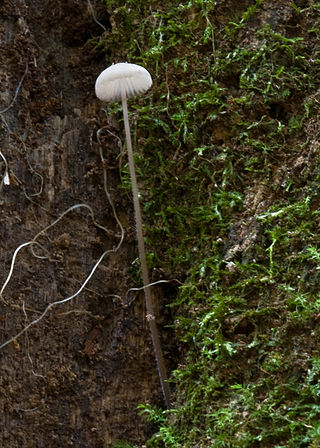
Mycena cystidiosa is a species of mushroom in the family Mycenaceae. Described as new to science in 1964, it is known only from New Zealand and Australia. The fruit bodies have a broadly conical small white cap up to 12 mm (0.5 in) wide, with distantly spaced cream-coloured gills on the underside. The stipe is particularly long, up to 20 cm (8 in), with an abundant covering of white hairs at the base. The species is known for its abundant rhizomorphs—long, root-like extensions of mycelia.

Marasmius funalis is a species of Marasmiaceae fungus known only from Japan. The species produces small mushrooms with reddish-brown caps up to 6 millimetres (0.24 in) in diameter and dark-brown, threadlike stems of up to 50 millimetres (2.0 in) in length. The species has a number of distinctive microscopic features, including very long cystidia on the stem, visible as bristles. Described in 2002 by Haruki Takahashi, the species grows on dead wood. The closest relative of M. funalis is M. liquidambari, known from Mexico and Papua New Guinea, and it is also similar in appearance to M. hudonii and Setulipes funaliformis, the latter of which was named after M. funalis.

Psathyrella ammophila is a species of fungus in the family Psathyrellaceae and is found throughout Europe. Commonly known as the dune brittlestem, this agaric primarily grows on sand dunes near marram grass, feeding saprotrophically on the decaying roots. The season of growth is generally May to November.

Cortinarius camphoratus, commonly known as the goatcheese webcap, is an agaric fungus in the family Cortinariaceae. The fungus is found in Europe and North America, where its fruit bodies (mushrooms) grow on the ground in a mycorrhizal association with spruce and firs in coniferous forests. Mushrooms are characterized by pale blue lilac colors when young, and a strong distinctive odor. Sources disagree as to the edibility of the mushroom, but they are generally not recommended for eating.

Psilocybe angulospora is a species of agaric fungus in the family Hymenogastraceae. The species was described from Taiwan in 2015 and is also present in New Zealand, where it is considered introduced. As a blueing member of the genus Psilocybe it contains the psychoactive compounds psilocin and psilocybin.

Crepidotus variabilis is a species of saprophytic fungi in the family Crepidotaceae. It is commonly known as a variable oysterling in the United Kingdom and is seen there in autumn. May occur solitary, but more often in small scattered groups from summer to autumn on twigs and other woody debris of broad-leaved trees. Very common but often confused with Crepidotus cesatii.

Crepidotus epibryus, is a species of saprophytic fungi in the family Crepidotaceae. It is commonly known as grass oysterling in the United Kingdom and is seen there in late summer and autumn.

Crepidotus affinis is a species of saprophytic fungus in the family Crepidotaceae with a stipeless sessile cap. The fungus was described by Egon Horak in 2018 and has been found in New Zealand, Panama, and the Philippines.

Crepidotus cesatii, commonly known as the roundspored oysterling, is a species of saprophytic fungus in the family Crepidotaceae with a stipeless sessile cap. It is often found on woody and herbaceous plant debris from many different hosts including conifers, appearing from late summer to winter usually in small scattered groups. Often confused with Crepidotus variabilis, it can be distinguished by its different spores.
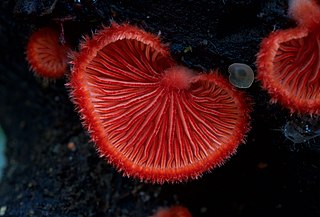
Crepidotus cinnabarinus is a species of saprophytic fungus in the family Crepidotaceae with a stipeless sessile cap distributed in North America and Europe. It is highly conspicuous and often found on fallen branches and rotting trunks of broad leafed trees. In England it appears from late summer to autumn.

This glossary of mycology is a list of definitions of terms and concepts relevant to mycology, the study of fungi. Terms in common with other fields, if repeated here, generally focus on their mycology-specific meaning. Related terms can be found in glossary of biology and glossary of botany, among others. List of Latin and Greek words commonly used in systematic names and Botanical Latin may also be relevant, although some prefixes and suffixes very common in mycology are repeated here for clarity.
Armillaria aotearoa is a species of mushroom-forming fungus in the family Physalacriaceae. This plant pathogen species is one of four Armillaria species that have been identified in New Zealand, the others being A. novae-zelandiae, A. limonea, and A. hinnulea.


